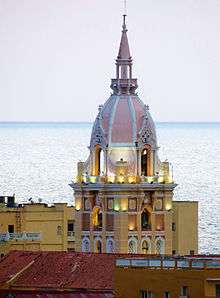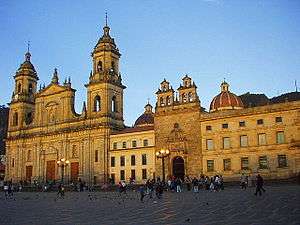Cartagena, Colombia
| Cartagena | |||
|---|---|---|---|
| City | |||
| Cartagena de Indias | |||
|
Top: Bocagrande Harbour. Second row: View of Santa Cruz Manga Island, Heredia Theatre. Third row: ClockTower (Torre del Reloj), Pilar Republicano, San Felipe Barajas Castle (Castillo de San Felipe de Barajas) (above), Charleston Hotel (below). Bottom: City Skyline. | |||
| |||
| Nickname(s): "The Magic City", "The Cosmopolitan City", "The city of Cartagena" | |||
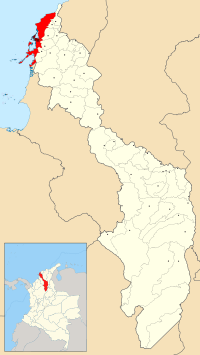 | |||
 Cartagena | |||
| Coordinates: 10°24′N 75°30′W / 10.400°N 75.500°WCoordinates: 10°24′N 75°30′W / 10.400°N 75.500°W | |||
| Country |
| ||
| Department |
| ||
| Region | Caribbean | ||
| Foundation | June 1, 1533 | ||
| Founded by | Pedro de Heredia | ||
| Government | |||
| • Mayor | Manuel Vicente Duque [1] | ||
| Area | |||
| • City | 572 km2 (221 sq mi) | ||
| Elevation | 2 m (7 ft) | ||
| Population (2006) | |||
| • City | 895,400 (approx.) (Census DANE 2,005) | ||
| • Rank | Ranked 5th | ||
| • Metro | 1,239,430 | ||
| Demonym(s) | Cartagenero(s) (Spanish) | ||
| Time zone | EST (UTC-5) | ||
| Postal code | 130000 | ||
| Area code(s) | 57 + 5 | ||
| HDI (2008) |
| ||
| Patron saints | Saint Catherine and Saint Sebastian | ||
| Average temperature | 82º | ||
| Website |
www | ||
The city of Cartagena, Cartagena de Indias in Spanish (Spanish pronunciation: [kartaˈxena ðe ˈindjas]), is a port located on the northern coast of Colombia in the Caribbean Coast Region; it is the capital of the Bolívar Department, and had a population 1.092 million as of 2015.[2] It is the fifth-largest city in Colombia and the second largest in the region, after Barranquilla. The urban area of Cartagena is also the fifth-largest urban area in the country. Economic activities include the maritime and petrochemicals industries, as well as tourism.
The city was founded on June 1, 1533, and named after Cartagena, Spain, which in turn was named after Carthage in Tunisia. Settlement in the region around Cartagena Bay by various indigenous people dates back to 4000 BC. During the Spanish colonial period Cartagena served a key role in administration and expansion of the Spanish empire. It was a center of political and economic activity due to the presence of royalty and wealthy viceroys. In 1984 Cartagena's colonial walled city and fortress were designated a UNESCO World Heritage Site.
History
| Port, Fortresses and Group of Monuments, Cartagena | |
|---|---|
| Name as inscribed on the World Heritage List | |
| Type | Cultural |
| Criteria | iv, vi |
| Reference | 285 |
| UNESCO region | Latin America and the Caribbean |
| Inscription history | |
| Inscription | 1980 (8th Session) |
Pre-Columbian era: 4000 BC – 1500 AD
The Puerto Hormiga Culture, found in the Caribbean coast region, particularly in the area from the Sinú River Delta to the Cartagena Bay, appears to be the first documented human community in what is now Colombia. Archaeologists estimate that around 4000 BC, the formative culture was located near the boundary between the present-day departments of Bolívar and Sucre. In this area, archaeologists have found the most ancient ceramic objects of the Americas, dating from around 4000 BC. The primary reason for the proliferation of primitive societies in this area is thought to have been the relative mildness of climate and the abundance of wildlife, which allowed the hunting inhabitants a comfortable life.[3][4][5]
Archaeological investigations date the decline of the Puerto Hormiga culture and its related settlements to around 3000 BC. The rise of a much more developed culture, the Monsú, who lived at the end of the Dique Canal near today's Cartagena neighborhoods Pasacaballos and Ciénaga Honda at the northernmost part of Barú Island, has been hypothesized. The Monsú culture appears to have inherited the Puerto Hormiga culture's use of the art of pottery and also to have developed a mixed economy of agriculture and basic manufacture. The Monsú people's diet was based mostly on shellfish and fresh and salt-water fish.[6]
The development of the Sinú society in what is today the departments of Córdoba and Sucre, eclipsed these first developments around the Cartagena Bay area. Until the Spanish colonization, many cultures derived from the Karib, Malibu and Arawak language families lived along the Colombian Caribbean coast. In the late pre-Columbian era, the Sierra Nevada de Santa Marta was home to the Tayrona people, whose language was closely related to the Chibcha language family.[7][8]
Around 1500 the area was inhabited by different tribes of the Karib language family, more precisely the Mocanae sub-family, including:
Some subsidiary tribes of the Kalamari lived in today's neighborhood of Pie de la Popa, and other subsidiaries from the Cospique lived in the Membrillal and Pasacaballos areas. Among these, according to the earliest documents available, the Kalamari had preeminence. These tribes, though physically and administratively separated, shared a common architecture, such as hut structures consisting of circular rooms with tall roofs, which were surrounded by defensive wooden palisades.[9]
First sightings by Europeans: 1500–1533
After the failed effort to find Antigua del Darién in 1506 by Alonso de Ojeda and the subsequent unsuccessful founding of San Sebastián de Urabá in 1517 by Diego de Nicuesa, the southern Caribbean coast became unattractive to colonizers. They preferred the better known Hispaniola and Cuba.[10]
Though the Casa de Contratación gave permission to Rodrigo de Bastidas (1460–1527) to again conduct an expedition as adelantado to this area, Bastidas explored the coast and discovered the Magdalena River Delta in his first journey from Guajira to the south in 1527, a trip that ended in the Gulf of Urabá, the location of the failed first settlements. De Nicuesa and De Ojeda noted the existence of a big bay on the way from Santo Domingo to Urabá and the Panama isthmus, and that encouraged Bastidas to investigate.[11][12][13][14]
Colonial era: 1533–1717

.jpg)
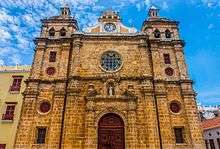
Cartagena was founded on June 1, 1533 by the Spanish commander, Pedro de Heredia, in the former location of the indigenous Caribbean Calamarí village. The town was named after Cartagena, Spain, where most of Heredia's sailors had resided.[15] The city first was settled by 200 Spanish immigrants in 1533, and during the remainder of the 16th century there was rapid population growth. A major attraction was the gold found in the tombs of the Sinú Culture. After those tombs were completely plundered, the inhabitants began to scatter to the countryside and to establish themselves as farmers, and the population of the city decreased.
A little later, the city had fewer than 2000 inhabitants and one church; the dramatically increasing fame and wealth of the prosperous city turned it into an attractive plunder site for pirates and corsairs–French and English privateers licensed by their king. Thirty years after its founding, the city was pillaged by the French nobleman Jean-François Roberval. The city set about strengthening its defenses and surrounding itself with walled compounds and castles.[16] Pirate Martin Cote attacked years later. A few months after the disaster of the invasion of Cote, a fire destroyed the city and forced the creation of a firefighting squad, the first in the Americas.[17]
In 1568, Sir John Hawkins of England tried to trick Governor Martín de las Alas into violating Spanish law by opening a foreign fair in the city to sell goods, which would have allowed Hawkins to ravage the port afterwards; the governor declined. Hawkins besieged the city, but failed to level it.[18][19][20]

After this disaster, Spain poured millions every year into the city for its protection, beginning with Gov. Francisco de Murga's planning of the walls and forts; this practice was called Situado. The magnitude of this subsidy is shown by comparison: between 1751 and 1810, the city received the sum of 20,912,677 Spanish reales.[21][22] The city recovered quickly from Drake's attack and subsequent occupation, and continued its growth and hence its inevitable attraction for predators, including a large group of pirates who attacked in late 1683. Nonetheless, trade began to increase, continuing into the 17th century. The city reached the peak of its development in 1698 before the arrival of the Baron de Pointis.
_-_Google_Art_Project.jpg)
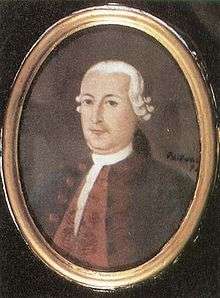
The Raid on Cartagena in 1697 by Sir Bernard Desjean, Baron de Pointis and Jean Baptiste Ducasse was an all-out invasion that was politically motivated. Absent a male successor to the Spanish Habsburg throne, King Louis XIV wanted his grandson Felipe V to assert the right of succession, and conquering Cartagena could help significantly. The political purpose behind the invasion was somewhat undermined by Ducasse, the governor of Saint-Domingue (today's Haiti), who brought his soldiers with an intent on thievery, but the invasions ended with pirates and thieves destroying the city. Entry to the city was hindered by the recently finished first stage of walls and forts, and the invasion was costly. While Desjean had asked for 250,000 Spanish reales in ransom, Ducasse stayed but a few months and did not honor the baron's promise to respect the churches and holy places. Ducasse left the inhabitants with nothing.
During the 17th century, the Spanish Crown paid for the services of prominent European military engineers to construct fortresses; today these are Cartagena's most significant identifiable features. Engineering works took well over 200 years, and ended with some 11 kilometres (6.8 mi) of walls surrounding the city, including the Castillo San Felipe de Barajas[23] named in honor of Spain's King Philip IV. The Castillo was built during the governorship of Pedro Zapata de Mendoza, Marquis of Barajas and was constructed to repel land attacks: it included buildings for food and weapons storage, and was equipped with sentry boxes and underground tunnels connecting the fortifications. The original fort was constructed between 1639 and 1657 on top of San Lazaro Hill; in 1762 extensive expansion was undertaken, and the final result is the current bastion. Numerous attempts to storm the reinforced fort were mounted, but it was never penetrated.
Cartagena was a major trading port, especially for precious metals. Gold and silver from the mines in the New Granada and Peru were loaded in Cartagena on the galleons bound for Spain via Havana. Cartagena was also a slave port; Cartagena and Veracruz, (Mexico), were the only cities authorized to trade African slaves. The first slaves were transported by Pedro de Heredia, and were used as cane cutters (allowing the new inhabitants to open roads), as laborers to destroy the tombs of the aboriginal population of Sinú, and to construct buildings and fortresses. The agents of the Portuguese company Cacheu sold slaves from Cartagena for working in mines in Venezuela, the West Indies, the Nuevo Reino de Granada and the Viceroyalty of Perú.
On February 5, 1610, the Catholic Monarchs established aInquisition Holy Office Court in Cartagena by a royal decree issued by King Philip II; with Lima in Peru, it was one of the three seats of the Inquisition in the Americas. The Palace of Inquisition, finished in 1770, preserves its original features of colonial times. When Cartagena declared its complete independence from Spain on November 11, 1811, the inquisitors were urged to leave the city. The Inquisition operated again after the Reconquest in 1815, but it disappeared entirely when Spain surrendered six years later to the troops led by Simón Bolívar.
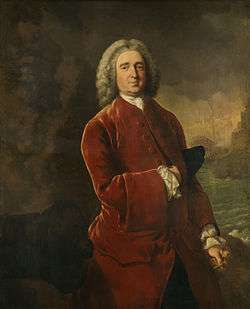

The census conducted by the mayor's office in 1712 reflected the damage wrought on the city by Jean Baptiste Ducasse and his forces: a major portion of the population of the city had emigrated.
Viceregal era: 1717–1811
Although the 18th century began very badly for the city, soon things began to improve. The pro-trade economic policies of the new dynasty in Madrid bolstered the economics of Cartagena, and the establishment of the Viceroyalty of the New Granada in 1717 placed the city in the position of being the greatest beneficiary of the colony. The 18th century brought the Bourbon dynasty and its pro-trade policies, and these benefited the city, returning it to prosperity again. During this period, the city passed the psychological barrier of 18,000 inhabitants, which was at the time the population cap of the Viceroyalty of New Granada.
The reconstruction after the Raid on Cartagena (1697) was initially slow, but with the end of the War of the Spanish Succession around 1711 and the competent administration of Juan Díaz de Torrezar Pimienta, the walls were rebuilt, the forts reorganized and restored, and the public services and buildings reopened. By 1710, the city was fully recovered. At the same time, the slow but steady reforms of the restricted trade policies in the Spanish Empire encouraged the establishment of new trade houses and private projects. During the reign of Philip V of Spain the city had many new public works projects either begun or completed, among them the new fort of San Fernando, the Hospital of the Obra Pía and the full paving of all the streets and the opening of new roads.
1741 attack
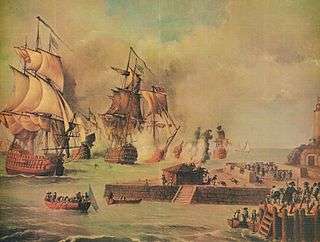
In March 1741, the city endured a large-scale attack by British and American colonial troops led by Admiral Edward Vernon (1684–1757), who arrived at Cartagena with a massive fleet of 186 ships and 23,600 men, including 12,000 infantry, against six Spanish ships and fewer than 3,000 men, in an action known as the Battle of Cartagena, part of the War of Jenkin's Ear. The siege was broken off due to the start of the tropical rainy season, after weeks of intense fighting in which the Spanish and native forces successfully repelled the British landing party. Commander General Blas de Lezo y Olavarrieta, a Basque from the Guipuzcoa province in northern Spain led the Spanish forces, but died in the aftermath of the battle.
Heavy British casualties were compounded by diseases such as yellow fever. This victory prolonged Spain's control of the Caribbean waters, which helped secure its large Empire until the 19th century. Admiral Vernon was accompanied by American Colonial troops, including George Washington's brother, Lawrence Washington, who was so impressed with Vernon that he named his Mount Vernon estate and plantation after him.
Silver Age (1750–1808)
After Vernon, what is called the 'Silver Age' of the city (1750–1808) began. This time was one of permanent expansion of the existing buildings, massive immigration from all the other cities of the Viceroyalty, increase of the economic and political power of the city and a population growth spurt not equaled since that time. Political power that was already shifting from Bogotá to the coast completed its relocation, and the Viceroys decided to reside in Cartagena permanently. The inhabitants of the city were the richest of the colony, the aristocracy erected noble houses on their lands to form great estates, libraries and printing establishments were opened, and the first café in New Granada was even established. The good times of steady progress and advancement in the second half of the 18th century came to an abrupt end in 1808 with the general crisis of the Spanish Empire that came from the Mutiny of Aranjuez and all its consequences.
Among the censuses of the 18th century was the special Census of 1778, imposed by the governor of the time, D. Juan de Torrezar Diaz Pimienta – later Viceroy of New Granada – by order of the Marquis of Ensenada, Minister of Finance – so that he would be provided numbers for his Catastro tax project, which imposed a universal property tax he believed would contribute to the economy while at the same time increasing royal revenues dramatically. The Census of 1778, besides having significance for economic history, is interesting because each house had to be described in detail and its occupants enumerated, making the census an important tool[25] The census revealed what Ensenada had hoped. However, his enemies in the court convinced King Charles III to oppose the tax plan.
1811 to the 21st century
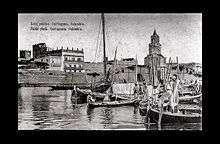
For more than 275 years, Cartagena was under Spanish rule. On November 11, 1811, Cartagena declared its independence. It had been the biggest city of the Viceroyalty until 1811, when the Peninsular War, which became Wars of Independence and Piñeres's Revolts, marked the beginning of a dramatic decline in all aspects for what had become the virtual capital of New Granada. In 1815 the city was almost destroyed. No census information exists for that time. There are accounts of how the city became a ghost town. Around 500 impoverished freed slaves dwelt the city, whose palaces and public buildings became ruins, many with collapsed walls.
By mid-1815 a large Spanish expeditionary fleet under Pablo Morillo had arrived in New Granada and forces besieged Cartagena. After a five-month siege the fortified city fell on December 1815. By 1816, the combined efforts of Spanish and colonial forces, marching south from Cartagena and north from royalist strongholds in Quito, Pasto, and Popayán, completed the reconquest of New Granada, taking Bogotá on May 6, 1816.
In 1821 the general Mariano Montilla conducted the pivotal siege of Cartagena assisted by naval forces under José Prudencio Padilla. The city fell on October 10, 1821 after a siege lasting 159 days. Among the defenders who surrendered was Brigadier Gabriel Torres, commander of the royalist forces. The patriots captured large stores of gunpowder, lead, rifles and field pieces.
Geography

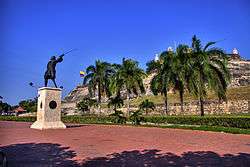
Location
Cartagena faces the Caribbean Sea to the west. To the south is the Cartagena Bay, which has two entrances: Bocachica (Small Mouth) in the south, and Bocagrande (Big Mouth) in the north. Cartagena is located at 10°25' North, 75°32' West (10.41667, −75.5333).[26]
Neighborhoods
The metropolitan area of Cartagena is formed by:
Northern area
In this area is the Rafael Núñez International Airport, located in the neighborhood of Crespo, ten minutes' drive from downtown or the old part of the city and fifteen minutes away from the modern area. Zona Norte, the area located immediately north of the airport contains the Hotel Las Americas, the urban development office of Barcelona de Indias, and several educational institutions.
Downtown
The Downtown area of Cartagena has varied architecture, mainly a colonial style, but republican and Italian style buildings, such as the Cathedral's bell tower, can be seen.
The main entrance to downtown is the Puerta del Reloj (Clock Gate), which exits onto the Plaza de los Coches (Square of the Carriages).[27] A few steps farther is the Plaza de la Aduana (Customs Square), next to the mayor's office. Nearby is San Pedro Claver Square and the church also named for Saint Peter Claver, where the body of the Jesuit saint ('Saint of the African slaves') is kept in a casket, as well as the Museum of Modern Art.
Nearby is the Plaza de Bolívar (Bolívar's Square) and the Palace of Inquisition. Plaza de Bolívar (formerly known as Plaza de La Inquisicion) is essentially a small park with a statue of Simón Bolívar in the center. This plaza is surrounded by balconied colonial buildings. Shaded outdoor cafes line the street.
The Office of Historical Archives devoted to Cartagena's history is not far away. Next to the archives is the Government Palace, the office building of the Governor of the Department of Bolivar. Across from the palace is the Cathedral of Cartagena, which dates back to the 16th century.
Another religious building of significance is the Iglesia de Santo Domingo in front of Plaza Santo Domingo (Santo Domingo Square). In the square is the sculpture Mujer Reclinada ("Reclining Woman"), a gift from the notable Colombian artist Fernando Botero. Nearby is the Tcherassi Hotel, a 250-year-old colonial mansion renovated by designer Silvia Tcherassi.
In the city is the Augustinian Fathers Convent and the University of Cartagena. This university is a center of higher education opened to the public in the late 19th century. The Claustro de Santa Teresa (Saint Theresa Cloister), which has been remodeled and has become a hotel operated by Charleston Hotels. It has its own square, protected by the San Francisco Bastion.
A 20-minute walk from downtown is the Castillo de San Felipe de Barajas, located in el Pie de la Popa (another neighborhood), the greatest fortress ever built by the Spaniards in their colonies. The tunnels were all constructed in such a way as to make it possible to hear footsteps of an approaching enemy. Some of the tunnels are open for viewing today.
San Diego
San Diego was named after the local San Diego Convent, now known as the Beaux Arts University Building. In front of it is the Convent of the Nuns of the Order of Saint Clare, now the Hotel Santa Clara. In the surrounding area is Santo Toribio Church, the last church built in the Walled City. Next to it is Fernández de Madrid Square, honoring Cartagena's hero, José Fernández de Madrid, whose statue can be seen nearby.
Inside the Old City is found Las Bóvedas (The Vaults),[28] a construction attached to the walls of the Santa Catalina Fortress. From the top of this construction the Caribbean Sea is visible.
Getsemaní

Once a district characterized by crime, Getsemani, just south of the ancient walled fortress, has become "Cartagena's hippest neighborhood and one of Latin America's newest hotspots", with plazas that were once the scene of drug dealing being reclaimed and old buildings being turned into boutique hotels.[29]
Bocagrande
The Bocagrande (Big Mouth) is an area known for its skyscrapers and it is said that it is reminiscent of "Manhattan" or "Miami Beach." The area contains the bulk of the city's tourist facilities, such as hotels, shops, restaurants, nightclubs and art galleries. It is located between Cartagena Bay to the east and the Caribbean Sea to the west, and includes the two neighborhoods of El Laguito (The Little Lake) and Castillogrande (Big Castle). Bocagrande has long beaches and much commercial activity is found along Avenida San Martín (Saint Martin Avenue).
The beaches of Bocagrande, lying along the northern shore, are made of volcanic sand, which is slightly grayish in color. This makes the water appear muddy, though it is not. There are breakwaters about every 200 yards (180 m).
On the bay side of the peninsula of Bocagrande is a seawalk. In the center of the bay is a statue of the Virgin Mary. The Naval Base is also located in Bocagrande, looking at the Bay.

Climate
Cartagena features a tropical wet and dry climate. Humidity averages around 90%, with rainy seasons typically in May–June and October–November. The climate tends to be hot and windy.
| Climate data for Cartagena (Rafael Núñez International Airport) 1981–2010 | |||||||||||||
|---|---|---|---|---|---|---|---|---|---|---|---|---|---|
| Month | Jan | Feb | Mar | Apr | May | Jun | Jul | Aug | Sep | Oct | Nov | Dec | Year |
| Record high °C (°F) | 40.0 (104) |
38.0 (100.4) |
38.0 (100.4) |
38.0 (100.4) |
40.0 (104) |
39.8 (103.6) |
39.0 (102.2) |
38.0 (100.4) |
39.6 (103.3) |
39.0 (102.2) |
40.0 (104) |
38.0 (100.4) |
40.0 (104) |
| Average high °C (°F) | 30.6 (87.1) |
30.7 (87.3) |
30.8 (87.4) |
31.2 (88.2) |
31.5 (88.7) |
31.8 (89.2) |
31.8 (89.2) |
31.8 (89.2) |
31.5 (88.7) |
31.2 (88.2) |
31.2 (88.2) |
30.9 (87.6) |
31.2 (88.2) |
| Daily mean °C (°F) | 26.7 (80.1) |
26.8 (80.2) |
27.1 (80.8) |
27.8 (82) |
28.3 (82.9) |
28.5 (83.3) |
28.3 (82.9) |
28.4 (83.1) |
28.3 (82.9) |
28.0 (82.4) |
27.9 (82.2) |
27.2 (81) |
27.8 (82) |
| Average low °C (°F) | 23.9 (75) |
24.2 (75.6) |
24.8 (76.6) |
25.6 (78.1) |
25.9 (78.6) |
25.9 (78.6) |
25.6 (78.1) |
25.7 (78.3) |
25.6 (78.1) |
25.4 (77.7) |
25.4 (77.7) |
24.6 (76.3) |
25.2 (77.4) |
| Record low °C (°F) | 19.0 (66.2) |
19.0 (66.2) |
19.0 (66.2) |
19.5 (67.1) |
19.0 (66.2) |
19.0 (66.2) |
20.0 (68) |
18.0 (64.4) |
18.5 (65.3) |
19.0 (66.2) |
19.0 (66.2) |
18.5 (65.3) |
18.0 (64.4) |
| Average rainfall mm (inches) | 1.9 (0.075) |
0.5 (0.02) |
1.9 (0.075) |
22.0 (0.866) |
120.3 (4.736) |
101.5 (3.996) |
119.4 (4.701) |
128.9 (5.075) |
144.5 (5.689) |
238.8 (9.402) |
156.9 (6.177) |
50.4 (1.984) |
1,087 (42.795) |
| Average rainy days | 0 | 0 | 1 | 4 | 10 | 13 | 11 | 13 | 15 | 16 | 12 | 3 | 98 |
| Average relative humidity (%) | 81 | 79 | 80 | 81 | 82 | 82 | 81 | 82 | 82 | 83 | 83 | 82 | 81 |
| Mean monthly sunshine hours | 272.8 | 240.1 | 238.7 | 210.0 | 192.2 | 189.0 | 207.7 | 198.4 | 171.0 | 170.5 | 186.0 | 241.8 | 2,518.2 |
| Mean daily sunshine hours | 8.8 | 8.5 | 7.7 | 7.0 | 6.2 | 6.3 | 6.7 | 6.4 | 5.7 | 5.5 | 6.2 | 7.8 | 6.9 |
| Source: Instituto de Hidrologia Meteorologia y Estudios Ambientales[30][31][32] | |||||||||||||
Demographics

| Year | Total City |
| 1939 | 87,504 |
| 1952 | 123,439 |
| 1967 | 299,493 |
| 1976 | 312,520 |
| 1985 | 554,093 |
| 1993 | 725,072 |
| 1999 | 837,552 |
| 2005 | 893,033 |
| 2011 | 955,709 Projected |
| 2013 | 978,600 Projected |
| Year | Total City |
| 1811 | 29,320 |
| 1821 | 5,392 |
| 1832 | 8,001 |
| 1842 | 4,221 |
| 1853 | 6,403 |
| 1867 | 8,320 |
| 1870 | 7,680 |
| 1882 | 13,994 |
| 1890 | 17,392 |
| 1900 | 21,220 |
| 1912 | 29,922 |
| 1918 | 34,203 |
| 1926 | 64,322 |
| Year | Total City |
| 1533 | 200 |
| 1564 | 2,400 |
| 1593 | 3,543 |
| 1612 | 5,302 |
| 1634 | 8,390 |
| 1643 | 12,302 |
| 1698 | 14,223 |
| 1701 | 10,230 |
| 1732 | 12,932 |
| 1762 | 14,203 |
| 1778 | 16,940 |
| 1792 | 19,380 |
| 1803 | 23,402 |

Economy
Industry

Other prominent companies include Cementos Argos, Miss Colombia, Kola Román, Indufrial, Amazon Pepper, Vikings SA, Distribuidora Ltda Refrigeration, Central Ingenio Colombia, Perfumery Lemaitre, Cartagena Refinery Cellux Colombiana SA, Flour Three Castles, Polyban International SA, SABMiller, Dow Chemical, Cemex, Dole, and Abocol..
Miss Colombia
In 1934, Miss Colombia was founded in Cartagena de Indias. Known as Concurso Nacional de Belleza de Colombia (National Beauty Contest of Colombia), it is a national beauty pageant in Colombia. The winner, Señorita Colombia, is sent to Miss Universe and the first runner-up, Señorita Colombia Internacional or Virreina, to Miss International.
Free zones
Free zones are areas within the local territory which enjoy special customs and tax rules. They are intended to promote the industrialization of goods and provision of services aimed primarily at foreign markets and also the domestic market.
- Central Park Zone SAS: Located in the municipality of Turbaco in conurbation area with the District of Cartagena de Indias, which has 64.8 hectares in the first phase and a second extension underway to complete the 128 acres (52 ha) included in the project. It has excellent design features and will have the most modern software inventory of Colombia. It has a permamente Zone (Phase 1 - Phase 2) and a Logistics and Commercial Zone for SMEs. They are currently on sale and rent their warehouses, lots, yards and offices for companies in different cluster.
- Zona Franca Industrial Goods and Services ZOFRANCA Cartagena SA: located 14 kilometres (8.7 miles) from the city center, at the end of the industrial sector and has Mamonal private dock.
- Tourist Zone: located on the island of Baru, within the swamp Portonaito, is the only tourist zone offers lots of water in waterways, marine tourism and urban development, villas and all conveniences of a Caribbean urbanization.
Commercial
Cartagena has a rising commercial vocation, to be a city of more than 900,000 people and become tourist destination, the city offers a wide range of shops where they are recognized chain stores, department stores, international franchise and specialized areas trade.
Construction

Tourism
.jpg)
Tourism is a mainstay of the economy. The following are tourist sites within the city:
- Colonial architecture with Andalusian style roots.
- Steps of La Popa mount[33]
- Castillo de San Felipe de Barajas[34]
- The Walled city of Cartagena
- Cartagena Gold Museum[35]
- Palace of the Inquisition[36]
- Las Bóvedas
- Clock Tower[37]
- Fortresses in Cartagena de Indias: Of the twenty fortresses comprising the walls in the district of Getsemaní, today 16 are still standing, preserved in good condition. In 1586, was commissioned to the most famous military engineer of the Crown of Spain in that time, the Italian Battista Antonelli, the fortification of the city. The works of the project finally ended in the 17th century; Cartagena became an impregnable bastion, which successfully resisted the attacks of Baron Pontis to 1697. In the 18th century, new additions gave the fortified complex its current amplitude by engineer Antonio de Arévalo. The initial fortification system includes only the urban recint, the bastion port of San Matías at the entrance to the passage of Bocagrande, and the Tower of San Felipe del Boquerón that controlled the Bay of las Ánimas. Gradually, all passages were dominated by fortresses: fortress of San Luis, fortress of San José and fortress of San Fernando in Bocachica, fortress of San Rafaél and fortress of Santa Bárbara in Pochachica (the passage at southwest), fortress of Santa Cruz, fortress of San Juan de Manzanillo and fortress of San Sebasi de Pastellilo around the interior of Bahía, castle of San Felipe de Barajas, in the rock that dominates the city from the east and access to protected the Isthmus del Cerebro. The fortifications of San Felipe de Barajas in Cartagena, protected the city during numerous sieges, giving its character and reputation unassailable. These are described as a masterpiece of Spanish military engineering in the Americas.
-

Fortress of San Fernando de Bocachica
-
Bastion of la Merced
-
Bastion of Santo Domingo Javier
-

Bastion of Santa Clara
Infrastructure

Transportation
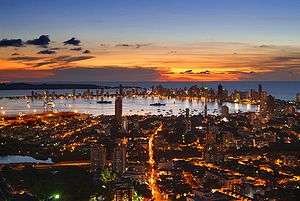
As the commercial and touristic hub of the country, the city has many transportation facilities, particularly in the seaport, air, and fluvial areas.
In 2003,[38] the city started building Transcaribe, a mass transit system. In 2015 the system began operating in the city
Roads
The city is linked to the northern part of the Caribbean Region through roads 90 and 90A, more commonly called Central Caribbean Road. This Road passes through Barranquilla, Santa Marta and Riohacha ending in Paraguachón, Venezuela and continues with Venezuelan numeration all the way to Caracas. Taxis in the city perimeter do not have fare meters.
The following roads are in the southeast portion of the city:
Road 25: Going through Turbaco and Arjona, and through the Montes de María when a fork divides it continuing to Sincelejo as National 25 and finally ending in Medellín, and to the east to Valledupar as number 80.
Road 25 A: Going also to Sincelejo, but avoiding the mountains, connects with Road 25 in the forementioned city.
Air
The Rafael Núñez International Airport, is the busiest airport in Colombia's Caribbean region and the fourth in passenger traffic in the country. The code of the airport is CTG, having flights to almost all airports in Colombia including Bogota's Eldorado International Airport. Excessive operational costs and easier connection travel and better prices had led to the shifting of the Rafael Núñez's international connection passengers away from Bogota to the nearer Tocumen International Airport in Panama and Queen Beatrix International Airport in Aruba. Also more companies prefer to serve the Colombian market from Cartagena, due to better geographical and atmospheric conditions.[39]
Sea

The open ports of the City are:
- Port Society of Cartagena. Specialized in container management, the first of his class in the country, 3rd. busiest in the caribbean sea, and 99th ranked port in the world.[40]
- Muelles El Bosque (El Bosque Docks) Specialized in grain storage, expanding to the container market.[41]
- Container Terminal of Cartagena Container management.
Of the private ports of the city:
- The port of the Cartagena Oil Refinery (REFICAR S.A.)
- SABMiller brewery port.
- Argos cement port.
- Dow Chemical raw materials embarkment port
- BASF Colombia raw materials embarkment port
- Du Pont private embarkment port
- Cemex cement port.
- Dole Packing house
- Colombian Navy Steelworks port.
Canals
Since the 17th century the bay has been connected to the Magdalena River by the Dique Canal, built by Governor Pedro Zapata de Mendoza. After Colombian independence, the canal was abandoned. Increasing centralization left the city without resources to maintain it. The last important maintenance work was done in the 1950s during Laureano Gómez's administration. Some improvements were made by local authorities in the 1980s. This was discontinued because of legal objections from the central government that decreed that the "maintenance" of the canal did not fall under the jurisdiction of the local government. From then on, maintenance of the canal has been delayed, though it is still functional.[42]
Cartagenian political leaders have argued that this state of affairs might change with a return to pre-independence funding and tax system. Under such systems the canal would be maintained properly and even expanded, benefiting the national economy.[43]
Waste disposal
Cartagena is one of the few cities in the world with a submarine emissary inaugurated in 2013. The emissary is the third largest in the world.
Education
Colleges and universities
Primary and secondary schools
International schools include:
- Corporacion Educativa Colegio Britanico de Cartagena (British)
- Colegio Jorge Washington (American)
Libraries
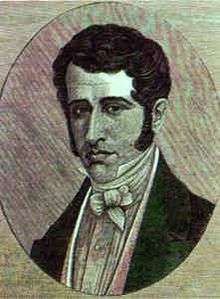
The city has many public and private libraries:
- The Universidad de Cartagena José Fernández Madrid Library: Started in 1821 when the university opened as the "University of Magdalena and Ithsmus". Serves mainly the students and faculty of this university but anyone can use its services.
- Divided in buildings across the city being assigned to the Faculties it serves accordingly each area. The main building is in C. de la Universidad 64 and the second biggest section is located in Av. Jose Vicente Mogollón 2839.[44]
- The Bartolomé Calvo Library: Founded in 1843 and established in its current place in 1900 is one of the main libraries of the Caribbean Coast and the biggest of the city. Its address is: C. de la Inquisición, 23.
- The History Academy of Cartagena de Indias Library: Opened in 1903, many of its books date from more than a century before from donations of members and benefactors. Its entrance is more restricted due to secure handling procedure reasons as ancient books require, but it can be requested in the Academy office in Plaza de Bolivar 112.
- The Technological University of Bolívar Library: Opened in 1985 Although small in general size, its sections on engineering and electronics are immense and its demand is mostly on this area, being located in Camino de Arroyohondo 1829.
- The American Hispanic Culture Library: Opened in 1999, it already existed a smaller version without Spanish funding in the Casa de España since the early 1940s but in 1999 was enlarged to serve Latin America and the Caribbean in the old convent of Santo Domingo. It specializes in Hispanic Culture and History and is a continental epicenter of seminaries on history and restoration of buildings. The restoration of the convent and the enlargement of the library was and still is a personal project of Juan Carlos I of Spain who visits it regularly. It is located in Plaza Santo Domingo 30, but its entrance is in C. Gastelbondo 52.
- Jorge Artel Library: Opened in 1997, serves the area of the southwest districts of the city, it is mostly for children. It is located in Camino del Socorro 222
- Balbino Carreazo Library: Located in Pasacaballos, a suburban neighborhood of the southeastern part of the city, serves mostly the suburbs of Pasacaballos, Ararca, Leticia del Dique and Matunilla. It is located in Plaza de Pasacaballos 321
- District Libraries: Although small, this system goes grassroots to neighborhoods circulating books, generally each district library has around 5000 books.[45]
Culture
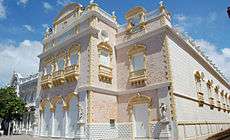

Theatres and concert halls
The first carnivals and western theaters that served in New Granada operated on, what is today, Calle del Coliseo. This was an activity patronized by the Viceroy Manuel de Guirior and Antonio Caballero y Góngora, who, like their predecessors, spent most of the time of their mandates ruling in Cartagena.
- Heredia Theatre: Opened in 1911, inspired by the Teatro Tacón of Havana, was designed by Jose Enrique Jaspe. After years of abandonment, it was rebuilt in the 1990s and continues to be a cultural center. It is located in Plazuela de La Merced 5.[46]
Museums and galleries
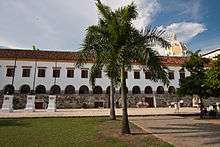

- City Museum Palace of the Inquisition, opened in the 1970s.
World Heritage site
The port, the fortresses and the group of monuments of Cartagena were selected in 1984 by the United Nations Educational, Scientific and Cultural Organization (UNESCO) as significant to the heritage of the world, having the most extensive fortifications in South America. They are significant, too, for being located in a bay that is part of the Caribbean Sea. A system of zones divides the city into three neighborhoods: San Sebastian and Santa Catalina with the cathedral and many palaces where the wealthy lived and the main government buildings functioned; San Diego or Santo Toribio, where merchants and the middle class lived; and Getsemani, the suburban popular quarters.[47]
Festivities
- January: The "Cartagena International Music Festival", (Cartagena Festival Internacional de Música) Classical music event that has become one of the most important festivals in the country. It is done in the Walled City for 10 days, which are held classes, conferences and counted with the presence of national and international artists,
- "Fiesta Taurina del Caribe" (Caribbean Bullfight festival) (ultimately canceled, for maintenance of the scenario),
- "Hay Festival",
- "SummerLand Festival": Electronic music festival most important of the country.
- May: "Fiestas de Nuestra Señora de la Candelaria" (Feasts of Our Lady of Candelaria),
- "Festival del Frito".
- March: "International Film Festival of Cartagena" (Festival Internacional de Cine de Cartagena),
- "Feria Nautica".
- Abril: "Festival del Dulce" (Festival of the Sweets).
- June–July: "Festival de Verano" (Summer Festival),
- "Sail Cartagena".
- Noviembre: "Fiestas del 11 de noviembre" (Feasts of November 11) or (of the Independence), during which is celebrated the Miss Colombia.
- December: "Jazz Festival under the Moon" (Festival de Jazz bajo la Luna),
- "Cartagena Rock".
Media references
Film
- Burn! (1969), with Marlon Brando, was filmed in Cartagena.
- In the movie Romancing the Stone (1984), romance novelist Joan Wilder (Kathleen Turner) travels to Cartagena to deliver a treasure map, in an effort to ransom her kidnapped sister. The Cartagena scenes were actually filmed in Mexico. In the movie, Michael Douglas' character refers to it as Cartage(ny)a. This has largely been adopted by tourists and is an irritant to the locals. The "N" in Cartagena is hard.
- The film The Mission (1986), with Robert De Niro, was filmed in Cartagena and Brazil.
- The film Love in the Time of Cholera (2007) was filmed in Cartagena.
Television
- In the Family Guy episode "Barely Legal", the mayor, thinking the film is real, sends all the city's police officers to Cartagena.
- Cartagena figured prominently in the "Smuggler's Blues" (1985) episode of Miami Vice, featuring guest star Glenn Frey and his song "Smuggler's Blues".
- Cartagena is featured as the backdrop for the NCIS episode "Agent Afloat".
Literature
- A fictionalized version of the 1697 raid on Cartagena is chronicled in the novel Captain Blood (1922).
- Gabriel García Márquez's novel Love in the Time of Cholera (1985) although set in an unnamed city, is obviously in Cartagena. Also set in Cartagena, partially or totally, are other novels of his, among them The General in His Labyrinth and Strange Pilgrims.
- Gabriel García Márquez's novel Of Love and Other Demons (1994) takes place in Cartagena in the 1600s
- The first chapter of Brian Jacques' novel The Angel's Command (2003) takes place in Cartagena in 1628.
- The poem "Románc" (1983) by Sándor Kányádi talks about the beauty of Cartagena.
- The second story in Nam Le's award-winning book of short fiction, The Boat (2008) is called "Cartagena" and set in Colombia. Cartagena in the story is more an idea than a place.
- A portion of the 2014 novel The Bone Clocks by David Mitchell (author) is set in the city.
- A 2015 novel by Claudia Amengual is named Cartagena.
Video games
- The city is the scene of two levels in the video game, Uncharted 3: Drake's Deception.[48]
Famous people
19th century
- José María García de Toledo, politician, early "juntismo" movement member, later independentist. President of the Supreme Junta of Cartagena (1810-1811) 4
- Bartolomé Calvo, politician, journalist. Governor of Panama (1856-1858), President of the Granadine Confederation in 1861.
- Rafael Núñez, politician, journalist, diplomat, writer, lawyer and judge. Dominant political figure in Colombia in the 19th century, and the first that did so by civil means: In 1848 just after another civil war entered in local politics. Then became MP for Cartagena in the Colombian Congress, also was Governor of Bolivar (1854), then briefly Minister of War in 1855-1857. President of the Sovereign State of Bolivar twice, (1876-1877) (1879-1880) was finally elected 4 times President of Colombia. During this time the country stabilized and the economy grew after decades of civil war and established the foundations for civil-led government with the Colombian Constitution of 1886 that lasted 105 years. Also wrote the country's national anthem.
20th century
- Julio Teherán, professional baseball player
- Joe Arroyo, Salsa music composer and singer
- Enrique Grau, painter, born in Panama but raised in the city where most of his work was done and inspired.
- Germán Espinosa, writer, author of "La Tejedora de Coronas" (The weaver of crowns) and other 40 works.
- Carlos Pizarro Leongómez, guerrilla fighter for the 19th of April Movement.
- Sabas Pretelt de la Vega, politician and ambassador, Minister of Interior (2003-2006)
- Dilson Herrera, professional baseball player
- Alvaro Barrios, conceptual artist
- Nereo Lopez, documentary photographer
Nearby towns and cities
 |
Caribbean Sea | Caribbean Sea, Bocacanoa | Bayunca, Clemencia |  |
| Caribbean Sea | |
Villanueva, Bolívar, San Estanislao | ||
| ||||
| | ||||
| Caribbean Sea | Tierra Bomba Island, Portonao. | Turbaco, Arjona |
Twin towns – Sister cities
Notes
- ↑ "Manuel Vicente "Manolo" Duque, se posesionó como alcalde de Cartagena" [Vicente Manuel "Manolo" Duque inaugurated as mayor of Cartagena]. El Universal (in Spanish). 1 January 2016. Retrieved 9 October 2016.
- ↑ "The World Factbook — Central Intelligence Agency — South America: Colombia". www.cia.gov. Central Intelligence Agency. 19 June 2008. Archived from the original on July 8, 2008. Retrieved 2 December 2016.
- ↑ "Biblioteca Luis Ángel Arango". Lablaa.org. Retrieved 2013-03-26.
- ↑ "Colombia Pais Maravilloso". Pwp.supercabletv.net.co. Retrieved 2010-06-24.
- ↑ "Universidad del Norte". Uninorte.edu.co. Retrieved 2010-06-24.
- ↑ "Biblioteca Luis Ángel Arango". Lablaa.org. June 4, 2005. Archived from the original on December 1, 2008. Retrieved 2010-06-24.
- ↑ "X Cátedra de Historia Ernesto Restrepo Tirado – "El Caribe en la Nación Colombiana" Guerra, Langbaek et al. Ed. Aguilar, Bogotá, 2007. ISBN 958-8250-31-5.
- ↑ Allaire, Louis (1997). "The Caribs of the Lesser Antilles". In Samuel M. Wilson, The Indigenous People of the Caribbean, pp. 180–185. Gainesville, Florida: University of Florida. ISBN 0-8130-1531-6.
- ↑ Lemaitre, Eduardo; Historia Extensa de Cartagena de Indias, Ed. Aguilar 1976. Edited before the ISBN system was enforced in Colombia, no reedition.
- ↑ "Diego de Nicuesa". Bruceruiz.net. 2002-04-22. Retrieved 2010-06-24.
- ↑ Related Articles. "Rodrigo de Bastidas (Colombian explorer) – Britannica Online Encyclopedia". Britannica.com. Retrieved 2010-06-24.
- ↑ "Rodrigo de Bastidas". Bruceruiz.net. 2002-07-03. Retrieved 2010-06-24.
- ↑ Lemaitre, Eduardo; Historia Extensa de Cartagena de Indias, Ed. Aguilar 1976.
- ↑ Corrales, Manuel Ezequiel; Documentos para la historia de la Provincia de Cartagena, Tomo II, Imp. M. Rivas, Cartagena de Indias, 1883.
- ↑ "Biblioteca Luis Ángel Arango". Lablaa.org. 2005-06-01. Retrieved 2010-06-24.
- ↑ "Pirate Encyclopedia: Port of Cartagena". Ageofpirates.com. Retrieved 2010-06-24.
- ↑ De Castellanos, Juan; Historia de Cartagena, Bogotá: Biblioteca de Cultura Popular de Colombia, 1942.
- ↑ "Historia general y natural de las Indias, islas y tierra-firme del mar océano. Primera parte – Biblioteca Virtual Miguel de Cervantes". Cervantesvirtual.com. Retrieved 2010-06-24.
- ↑ "Sir John Hawkins". Spartacus.schoolnet.co.uk. Retrieved 2010-06-24.
- ↑ Hamilton, Alan (2006-06-22). "Slavers descendant begs forgiveness". The Times. London. Retrieved 2010-04-28.
- ↑ Meisel Roca, Adolfo (April 2002). "Crecimiento a Traves de los Subsidios: Cartagena de Indias y el Situado, 1751-1810" [Growth Through Subsidies: Cartagena de Indias and Surrounding Area, 1751–1810] (PDF). Cuadernos de Historia Económica y Empresarial [Journal of History, Economics, and Business] (in Spanish). Archived from the original (PDF) on 13 May 2013. Retrieved 9 October 2016.
- ↑ "The Caribean Raid 1585–1586: Sir Francis Drake: A Pictorial Biography by Hans P. Kraus (Rare Book and Special Collections Reading Room, Library of Congress)". Loc.gov. 2005-10-25. Retrieved 2010-06-24.
- ↑ "Castillo San Felipe de Barajas". Incartagenaguide.com. Retrieved 9 October 2016.
- ↑ "The man that caused the greatest defeat ever suffered by the British Navy", sevilla.abc.es
- ↑ This is used today by restoration architects in Cartagena's city center. The original of the census is preserved in the Museum of History of the city while a copy rests in the Archivo de Indias in Seville
- ↑ "Country Files (GNS)". National Geospatial-Intelligence Agency. 14 December 2015. Retrieved 18 December 2015.
- ↑ "La Torre del Reloj Testigo Silencioso de un pasado" [The Clock Tower: Silent Witness to the Past]. Traviata Nuestra (in Spanish). Retrieved 10 October 2016.
- ↑ "Cartagena attractions: Las Bovedas". Viator. Retrieved 11 December 2013.
- ↑ Saladino, Emily (23 August 2013). "A renaissance beyond Cartagena's historic walls". Travel. BBC. Retrieved 24 August 2016.
- ↑ "Promedios Climatológicos 1981–2010" (in Spanish). Instituto de Hidrologia Meteorologia y Estudios Ambientales. Archived from the original on August 15, 2016. Retrieved 15 August 2016.
- ↑ "Promedios Climatológicos 1971–2000" (in Spanish). Instituto de Hidrologia Meteorologia y Estudios Ambientales. Archived from the original on August 15, 2016. Retrieved 15 August 2016.
- ↑ "Tiempo y Clima" (in Spanish). Instituto de Hidrologia Meteorologia y Estudios Ambientales. Archived from the original on August 15, 2016. Retrieved 15 August 2016.
- ↑ "Cerro de la Popa". Retrieved February 19, 2015.
- ↑ History, pictures and rates
- ↑ "Museo del Oro de Cartagena". Retrieved February 19, 2015.
- ↑ "Palacio de la Inquisición". Retrieved February 19, 2015.
- ↑ "Torre del Reloj". Retrieved February 19, 2015.
- ↑ "Transcaribe". Transcaribe. Archived from the original on May 20, 2013. Retrieved 2013-03-26.
- ↑ "En Marzo Entregan Obras en el Aeropuerto". El Universal. Retrieved 20 February 2013.
- ↑ "Contecar – Sociedad Portuaria Regional Cartagena". Puertocartagena.com. Retrieved 2010-06-24.
- ↑ "Terminal Marítimo Muelles El Bosque S.A". Elbosque.com. Archived from the original on January 28, 2011. Retrieved 2010-06-24.
- ↑ Lemaitre, Eduardo; Historia Extensa de Cartagena de Indias, Ed. Aguilar 1976
- ↑ "El Porvenir", Year CXVII, Issue 29.399, Page 4, column 2. Cartagena de Indias, 1999.
- ↑ "Universidad de Cartagena – Biblioteca". Unicartagena.edu.co. Archived from the original on March 11, 2010. Retrieved 2010-06-24.
- ↑ "Patrimonio Cultural – Instituto de Cultura de Cartagena Colombia". Ipcc.gov.co. Archived from the original on June 23, 2007. Retrieved 2010-06-24.
- ↑ "Teatro Heredia" [Heredia Theatre]. Cartagena Travel (in Spanish). 2002. Archived from the original on April 23, 2002. Retrieved 9 July 2016.
- ↑ UNESCO World Heritage Centre. "Port, Fortresses and Group of Monuments, Cartagena". Retrieved February 19, 2015.
- ↑ Naughty Dog (November 1, 2011). Uncharted 3: Drake's Deception. PlayStation 3. Sony Computer Entertainment. Level/area: Chapter 2 - Greatness from Small Beginnings and Chapter 3 - Second Story Work.
External links
| Wikimedia Commons has media related to Cartagena de Indias. |
| Wikivoyage has a travel guide for Cartagena. |
| Wikisource has original text related to this article: |
| Wikisource has the text of the 1911 Encyclopædia Britannica article Cartagena (Colombia). |
- Reference volumes and maps regarding the history of Cartagena. Library of the Royal Geographical Society of South Australia
- (Spanish) Cartagena City Government website
- Map of the City and Bay of Cartagena de las Indias from 1735



_circa_1799.jpg)
_circa_1796.jpg)
